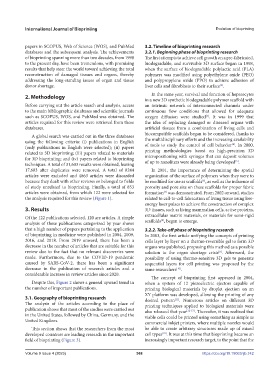Page 376 - IJB-9-4
P. 376
International Journal of Bioprinting Evolution of bioprinting
papers in SCOPUS, Web of Science (WOS), and PubMed 3.2. Timeline of bioprinting research
databases and the subsequent analysis. The achievements 3.2.1. Beginning phase of bioprinting research
of bioprinting spanning more than two decades, from 1998 The first attempts to achieve cell growth on a pre-fabricated,
to the present day, have been tremendous, with promising biodegradable, and survivable 3D surface began in 1998,
results that help steer the world toward achieving the total when the surface of biodegradable polylactic acid (PLA)
reconstruction of damaged tissues and organs, thereby polymers was modified using polyethylene oxide (PEO)
addressing the long-standing issues of organ and tissue and polypropylene oxide (PPO) to achieve adhesion of
donor shortage. liver cells and fibroblasts to their surface .
[2]
2. Methodology In the same year, survival and function of hepatocytes
in a new 3D synthetic biodegradable polymer scaffold with
Before carrying out the article search and analysis, access an intrinsic network of interconnected channels under
to the main bibliographic databases and scientific journals continuous flow conditions that allowed for adequate
such as SCOPUS, WOS, and PubMed was obtained. The oxygen diffusion were studied . It was in 1999 that
[3]
articles required for this review were retrieved from these the idea of replacing damaged or diseased organs with
databases. artificial tissues from a combination of living cells and
biocompatible scaffolds began to be considered, thanks to
A global search was carried out in the three databases
using the following criteria: (i) publications in English the multidisciplinary efforts and the increasing availability
[4]
of tools to study the control of cell behavior . In 2000,
(only publications in English were selected); (ii) papers printing methodologies based on high-precision 3D
related to 3D bioprinting; (iii) papers related to materials micropositioning with syringes that can deposit volumes
for 3D bioprinting; and (iv) papers related to bioprinting of up to nanoliters were already being developed .
[5]
techniques. A total of 31,603 results were obtained, leaving
17,603 after duplicates were removed. A total of 8244 In 2001, the importance of determining the spatial
articles were excluded and 4863 articles were discarded organization of the surface of polymers when they were to
because they dealt with other reviews or belonged to fields be modified for use as scaffolds , as well as the influence of
[6]
of study unrelated to bioprinting. Finally, a total of 853 porosity and pore size on these scaffolds for proper fabric
articles were obtained, from which 122 were selected for formation was demonstrated. From 2002 onward, studies
[7]
the analysis required for this review (Figure 1). related to cell-to-cell fabrication of living tissue using low-
energy laser pulses to achieve the construction of complex
3. Results 3D tissues, such as living mammalian cells, active proteins,
Of the 122 publications selected, 120 are articles. A simple extracellular matrix materials, or materials for semi-rigid
[8]
analysis of these publications categorized by year shows scaffolds , began to emerge.
that a high number of papers pertaining to the application 3.2.2. Take-off phase of bioprinting research
of bioprinting in medicine were published in 2004, 2009, In 2003, the first article unifying the concepts of printing
2016, and 2018. From 2019 onward, there has been a cells layer by layer on a thermo-reversible gel to form 3D
decrease in the number of articles that are suitable for this organs was published, proposing this method as a possible
review due to the fact that no relevant discoveries were solution to the organ shortage crisis . Afterward, the
[9]
made. Furthermore, due to the COVID-19 pandemic possibility of using thermo-sensitive 3D gels to generate
caused by SARS-CoV-2, there has been a significant sequential layers for cell printing was proposed by the
decrease in the publication of research articles and a same researchers .
[10]
considerable increase in review articles since 2020.
The concept of bioprinting first appeared in 2004,
Despite this, Figure 2 shows a general upward trend in when a system of 12 piezoelectric ejectors capable of
the number of important publications. printing biological materials by droplet ejection on an
XY platform was developed, allowing the printing of any
3.1. Geography of bioprinting research desired pattern . Numerous articles on different 3D
[11]
The analysis of the articles according to the place of printing techniques applied to biological materials were
publication shows that most of the studies were carried out also released that year [12-17] . Thereafter, it was realized that
in the United States, followed by China, Germany, and the viable cells could be printed using something as simple as
United Kingdom.
commercial inkjet printers, where multiple nozzles would
This section shows that the researchers from the most be able to create arbitrary structures made up of mixed
developed countries are leading research in the important cell types . It was at this time that bioprinting became an
[18]
field of bioprinting (Figure 3). increasingly important research target, to the point that the
Volume 9 Issue 4 (2023) 368 https://doi.org/10.18063/ijb.742

